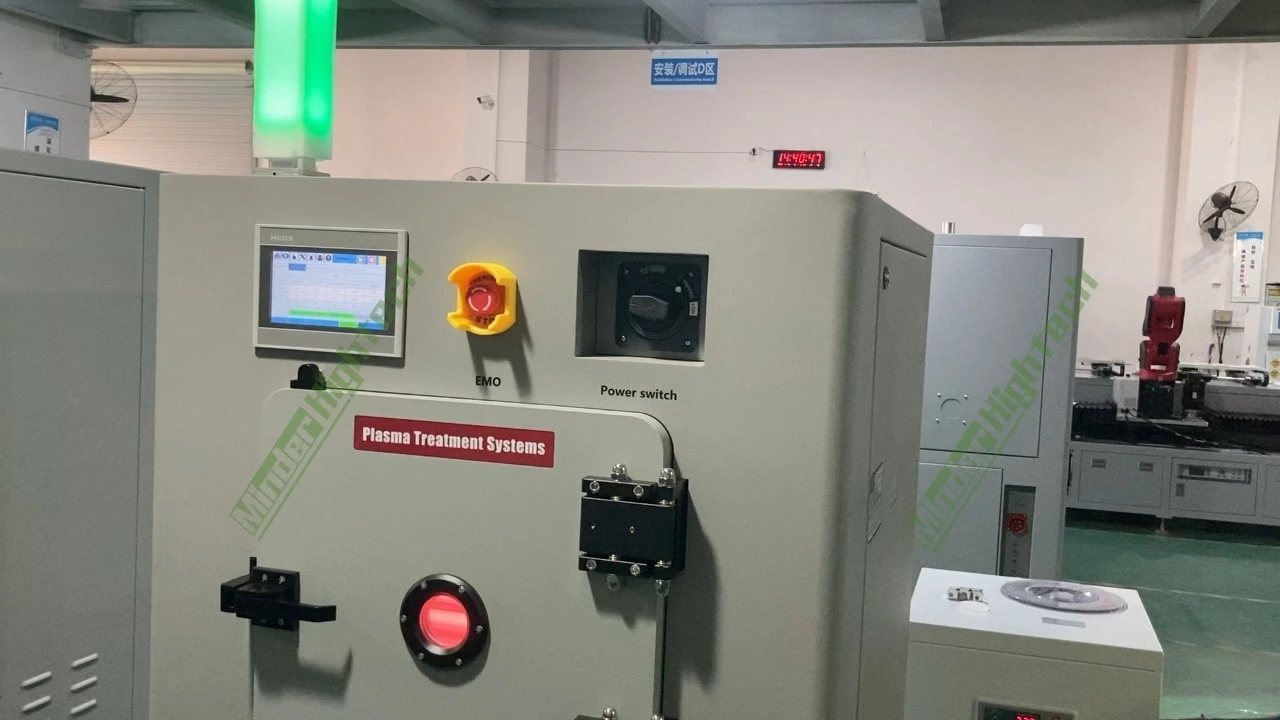MD-SPV150 Vacuum Plasma surface Treater
The principle of plasma cleaning is mainly:
(A)Etching on the surface of materials - physical effects
A large number of active particles in the plasma, such as a large number of ions, excited molecules, and free radicals, act on the surface of the solid sample, which not only removes the original contaminants and impurities, but also produces an etching effect to roughen the surface of the sample. Many fine pits are formed, increasing the surface ratio of the sample. Improve the wetting properties of solid surfaces.
(B)Activation bond energy, cross-linking
The energy of the particles in the plasma is between 0-20 eV, and most of the bonds in the polymer are between 0-10 eV.
When a solid surface is used, the original chemical bond on the solid surface can be broken, and the free radicals in the plasma and these bonds
The formation of a network of crosslinked structures greatly activates surface activity.
(C)Forming new functional groups - chemistry
If a reactive gas is introduced into the discharge gas, a complicated chemical reaction occurs on the surface of the activated material, and new functional groups such as a hydrocarbon group, an amino group, a carboxyl group, and the like are introduced, and these functional groups are all active groups, which can significantly improve the surface activity of the material.
Advantages of vacuum plasma cleaning:
Plasma cleaning is an important material surface modification method and has been widely used in many fields.
And some traditional cleaning methods, such as ultrasonic cleaning, UV cleaning, etc., have the following advantages:
(A)Low processing temperature
The processing temperature can be as low as 80 ° C - 50 ° C. Low processing temperatures ensure no thermal effects on the sample surface.
(B)No pollution during the whole process
The plasma cleaner itself is a very environmentally friendly device that does not cause any pollution,and does not cause any pollution during the treatment process.
(C)Stable processing effect
The treatment effect of plasma cleaning is very uniform and stable, and the effect of maintaining the sample after a long period of time is good.
(D)Can handle samples of various shapes
For complex shaped samples, plasma cleaning can find the right solution.
Vacuum plasma cleaning allows for the cleaning of the internal position of the solid sample.
The structure of the plasma cleaner is mainly divided into five major components: control system, Excitation power system, vacuum chamber, process gas system, and vacuum pump system.

(A)Control System:
The function of the control system is to control the operation of the entire device, including human-machine interface (touch screen), PLC, electrical circuit. Vacuum plasma cleaning with fully automatic control system enables multiple modes and multiple programs to control the cleaning equipment to meet the needs of different customers.
(B)Excitation power system:
There are three main types of excitation power: 40KHz intermediate frequency excitation power supply, 13.56MHz RF excitation power supply, and 2.45GHz microwave excitation power supply. At present, the industry mainly uses RF excitation power supply and intermediate frequency excitation power supply.For different applications.
(C)Vacuum chamber:
The vacuum chamber is mainly divided into three materials: 1) aluminum alloy cavity, 2) stainless steel vacuum chamber, 3) quartz cavity. Different discharge modes and different sample sizes and capacities can be achieved depending on the user's different needs.
(D)Process gas system:
Process gases include flow meters, pneumatic valves, etc. Users can flexibly choose multiple process gas solutions, argon, oxygen, hydrogen, nitrogen, carbon tetrafluoride, etc., to meet different process requirements. Clean the surface of various products.
(E)Vacuum pump:
The vacuum pump is divided into an oil pump, a dry pump and a Roots pump. The oil pump mainly adopts a two-stage rotary vane pump, and the vacuum pump is formulated according to the volume, work efficiency and environmental requirements of the user.
|
Power Systems |
China RF power supply:13.56MHz 0-1000W(Adjustable) China IF power supply: 40KHz,0-1000W(Adjustable) (IF power supply2000W, 3000W, 4000W optional) |
|
|
Fully automatic vacuum capacitor matcher |
|
|
|
Vacuum system |
Custom two-stage rotary vane pump(Oil pump):90m3/h |
|
|
Vacuum gauge: Japan Inficon Pirani vacuum gauge |
|
|
|
Vacuum line: all stainless steel line |
|
|
|
Cavity system |
Aluminum alloy material;Military grade welding |
|
|
Cavity internal dimensions:550*550*675mm(W*H*D) |
|
|
|
Electrode plate layout:Horizontal arrangement, extractable |
|
|
|
Work tray |
|
|
|
Space layer number:10 layers |
|
|
|
Gas system |
Pneumatic valve:Japan SMC |
|
|
Flow meter:China SevenStar:0-300SCCM |
|
|
|
Two process gases:Argon, oxygen |
||
|
Control system |
PLC:German SIEMENS S series |
|
|
Seven inch touchscreen: WEINVIEW |
|
|
|
Electrical parts:Schneider |
|
|
|
Other parameters |
Dimensions:1010*1715*1120mm(W*H*D) |
|
|
Weight:500kg |
|
|
|
Color:Silver |
|

